#egyptological
Explore tagged Tumblr posts
Text
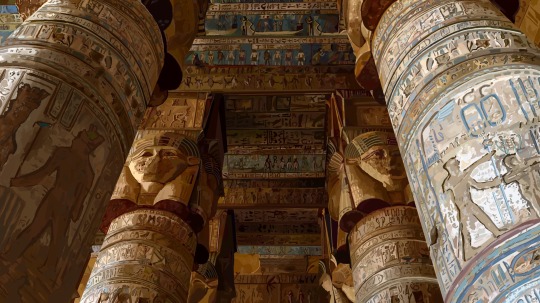
I know this isn't ninjago guys but I finished this 17 hour painting for my art class and I was proud of it so...enjoy.
I love Egypt fun fact about me. :) [ID: a detailed, realistic painting of the hathor columns at the dendera temple complex in dendera, egypt. /end ID]
#my art#art#egypt#egyptian#egyptology#egyptian art#ancient egypt#antiquity#ancient art#ancient egyptian#painting#digital painting
149K notes
·
View notes
Text
downside: going to have to include a picture of the Giza pyramids in the slides for the lecture upside: i get to give people a crash course in why perspective matters in two frames, because

followed by
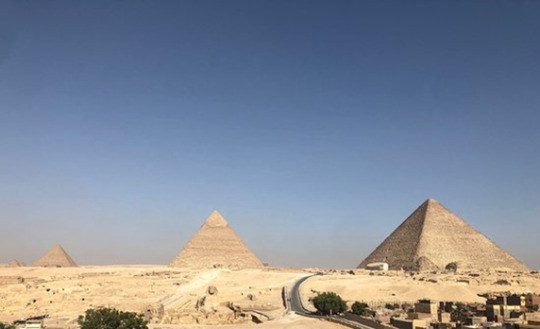
is such a funny sequence
194K notes
·
View notes
Text
Tumba Ramsés V y Ramsés VI (Dinastía XX) Valle de los Reyes. Egipto
4K notes
·
View notes
Text

Gold swivel ring featuring an amethyst frog, from the New Kingdom period of Egypt, dating between 1550-1229 BC.
#new kingdom#ancient egypt#egyptology#egyptian#egypt#frog art#frog#amethyst#purple and gold#gold jewelry#gold rings#egyptian history#egyptian archaeology#egyptian art#antique#antiquities#toya's tales#style#toyastales#toyas tales#art#ring#antique jewelry#world history#artifact#art history#swivel ring#amphibians#fashion#accessories
2K notes
·
View notes
Text




~ Wooden figure of the Anubis-jackal, with long tail.
Cultures/Period: Late Period
Place of origin: Egypt
Medium: Wood
#ancient#ancient art#history#museum#archeology#ancient egypt#ancient sculpture#ancient history#archaeology#egyptian#egyptology#egypt#late period#wood#anubis#jackal#lomg tail
3K notes
·
View notes
Text
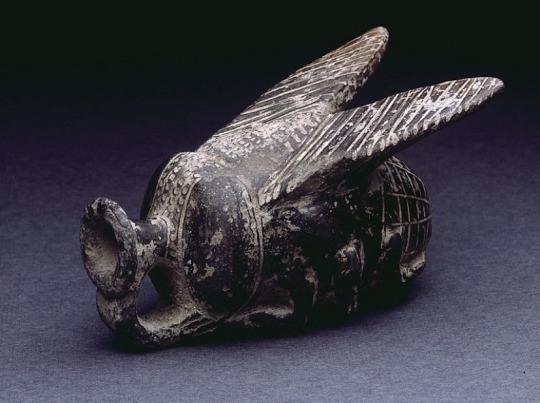
A kooky fly-shaped clay vessel (15th Dynasty)
With its realistic representation of a fly, it includes large eyes, wings, and legs that resemble hands
#art#lol#weird#archaeology#ancient#ancient art#egyptian art#egypt#egyptology#ancient egypt#clay#clay art#kemetic#ancient kemet#kemet
8K notes
·
View notes
Text
Child's Sock from Egypt, c.250-350 CE: this colorful sock is nearly 1,700 years old

This sock was discovered during excavations in the ancient city of Oxyrhynchus. It was likely created for a child during the late Roman period, c.250-350 CE.
Similar-looking socks from late antiquity and the early Byzantine period have also been found at several other sites throughout Egypt; these socks often have colorful, striped patterns with divided toes, and they were crafted out of wool using a technique known as nålbinding.

Above: a similar child's sock from Antinoöpolis, c.250-350 CE
The sock depicted above was created during the same period, and it was found in a midden heap (an ancient rubbish pit) in the city of Antinoöpolis. A multispectral imaging analysis of this sock yielded some interesting results back in 2018, as this article explains:
... analysis revealed that the sock contained seven hues of wool yarn woven together in a meticulous, stripy pattern. Just three natural, plant-based dyes—madder roots for red, woad leaves for blue and weld flowers for yellow—were used to create the different color combinations featured on the sock, according to Joanne Dyer, lead author of the study.
In the paper, she and her co-authors explain that the imaging technique also revealed how the colors were mixed to create hues of green, purple and orange: In some cases, fibers of different colors were spun together; in others, individual yarns went through multiple dye baths.
Such intricacy is pretty impressive, considering that the ancient sock is both “tiny” and “fragile."
Given its size and orientation, the researchers believe it may have been worn on a child’s left foot.

Above: another child's sock from Al Fayyum, c.300-500 CE
The ancient Egyptians employed a single-needle looping technique, often referred to as nålbindning, to create their socks. Notably, the approach could be used to separate the big toe and four other toes in the sock—which just may have given life to the ever-controversial socks-and-sandals trend.
Sources & More Info:
Manchester Museum: Child's Sock from Oxyrhynchus
British Museum: Sock from Antinoupolis
Royal Ontario Museum: Sock from Al Fayyum
Smithsonian Magazine: 1,700-Year-Old Sock Spins Yarn About Ancient Egyptian Fashion
The Guardian: Imaging Tool Unravels Secrets of Child's Sock from Ancient Egypt
PLOS ONE Journal: A Multispectral Imaging Approach Integrated into the Study of Late Antique Textiles from Egypt
National Museums Scotland: The Lost Sock
#archaeology#artifact#history#anthropology#child's sock#ancient textiles#ancient egypt#roman egypt#fabric arts#knitting#fashion#naalebinding#art#classical antiquity#children in archaeology#natural dyes#wool#yarn#ancient clothing#children#roman#sewing#egyptology#cute little stripy socks
2K notes
·
View notes
Text
it's mildly annoying when people compare emoji to hieroglyphs. like I get where the misconception comes from, but it's still a little bit frustrating to see
9K notes
·
View notes
Text

Mighty stone pillars in Luxor, Egypt
#karnak temple#el karnak#luxor#egypt#africa#egyptology#ancient egypt#travel#wanderlust#history#antiquity#ancient#ancient art#ancient history#archaeology#original photographers#photographers on tumblr#columns#column#pillars#archeology
892 notes
·
View notes
Text
Dark Platonic Ancient Egyptian Deities X Reincarnated! Reader
Ra (god of the Sun and King of the Gods)
As the father figure of the pantheon, Ra takes a patriarchal protector role. He insists you stay close to him in his solar barque, safe from the dangers of the mortal and divine realms.
He grows obsessive about shielding you from chaos especially Apophis, even refusing to let you leave his sight during the night.
Ra often calls you his 'ray of light,' claiming that your presence eases his eternal burden of maintaining Ma’at (cosmic order).
Isis (goddess of Magic and Motherhood)
Isis becomes a motherly figure, fiercely nurturing and protective.
She insists on teaching you spells and protective charms, even if they’re far too hard for you.
She forbids you from interacting with anyone she deems 'unworthy,' claiming she’s the only one who understands how to keep you safe.
Her possessiveness is crude and unyielding; she uses her magic to track you and ensure no harm comes to you, even if it means manipulating others around you.
Osiris (god of the Underworld and Rebirth)
Osiris is calm but quietly obsessive.
He views you as a symbol of renewal and life, a bright presence that balances his somber existence.
Maybe that's because he knows that you are a reincarnation?
Oh wait, he is the one who had you reincarnated in the first place.
He tries to keep you within his underworld domain, rationalizing that it’s the safest place for you, free from earthly or divine dangers.
Osiris has a slightly eerie way of expressing his affection, saying things like,
“You belong to eternity, just like I do.”
Anubis (god of Mummification and Protector of the Dead)
Anubis is like an older sibling who takes his role as your guardian far too seriously.
He constantly watches over you, often from the shadows.
His possessiveness appears as distrust of anyone else, mortal or divine, who tries to approach you.
He justifies this by claiming his duty as a protector.
If you ever get hurt, even slightly, he blames himself and becomes even more overbearing, ensuring no one gets close enough to harm you again.
As for the person who harms you, they will get mummified alive.
Horus (god of Kingship and Sky)
Horus is fiercely territorial, viewing you as his personal charge.
He sees himself as your rightful protector, fighting off any perceived threats to your safety or happiness.
And it doesn't help that his mother, Isis, encouraged him to be like that.
He’s competitive, constantly trying to prove that he’s the only one who can protect you.
He often gets into arguments with other gods over who should have custody of you.
His eagle-eyed vigilance means you’re rarely alone, as he swoops in at the slightest hint of trouble or perceived disobedience.
Set (god of Chaos and Storms)
Surprisingly, Set sees you as a calming impact in his chaotic life.
Your innocent, pure nature makes him protective, almost soft-hearted in your presence.
He grows extremely possessive, believing that only he understands what it means to protect you in a world full of danger and betrayal.
Set doesn’t shy away from using intimidation or brute force to keep others away from you, including the other gods.
He is the first one who suggests that the deities should turn you into immortal or even a goddess.
Thoth (god of Wisdom and Knowledge)
Thoth is fascinated by your knowledge of the modern world and becomes obsessed with learning everything he can from you.
He is the only one after Osiris that knows that you are reincarnated.
He justifies keeping you close, by saying it’s for 'scholarly purposes' yet we all know that he enjoys your childlike curiosity.
He tries to isolate you, offering endless books and scrolls while discouraging interactions with others, fearing they might distract or corrupt you.
"I have found a new rare scroll, who about we read it both together instead of going out for a walk?"
Bastet (goddess of Cats, Home, and Protection)
Bastet is smothering affectionate, treating you like a fragile kitten.
She insists on keeping you within her temples, surrounded by her sacred cats.
She’s fiercely territorial and sees anyone approaching you as a threat.
Her claws come out literally if anyone tries to take you away from her.
Bastet’s love is suffocatingly warm, she showers you with gifts, affection, and constant attention, leaving little room for independence.
Sekhmet (goddess of War and Healing)
Sekhmet is a ferocious guardian, seeing herself as your warrior and protector.
She’s quick to destroy anything or anyone by draining their blood, but only those who she perceives as a danger to you.
And she perceives every human as a danger.
Despite her fearsome nature, she’s surprisingly tender with you, often calling you “little one” and insisting on tending to your needs personally.
She becomes enraged at the idea of you being harmed or taken from her, leading to bursts of divine wrath that shake the mortal and divine realms.
Sobek (god of the Nile and Crocodiles)
Sobek views you as a fragile, precious being who needs constant protection.
He assigns himself as your personal guard, often scaring off others with his intimidating presence.
His possessive attitude appears in his insistence that you remain near water, claiming it’s the safest place for you.
He has a soft spot for you, often bringing you gifts like shiny trinkets or freshly caught fish.
"Why would you need to cook the fish, my dear? it's better if it is eaten raw."
#ancient egypt#egyptology#egypt mythology#horus x reader#set x reader#platonic#platonic yandere#reader insert
584 notes
·
View notes
Photo
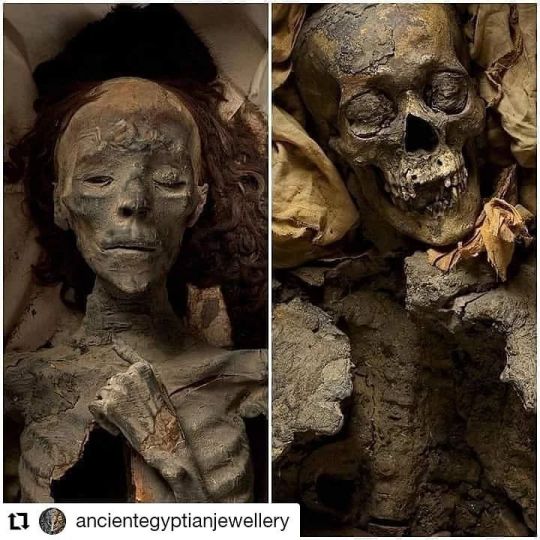
Posted @withregram • @ancientegyptianjewellery #Repost @ancientegyptianjewellery • • • • • • #Repost @ancientegyptianjewellery • • • • • • Egyptian Museum Mummy of Grandfather and Grandmother of King Tutankhamun .. King Amenhotep III ... and Queen Tiye 💚💚😍😍🥰🥰🇪🇬🇪🇬 مومياء جد وجدة الملك توت عنخ آمون .. الملك أمنحتب الثالث ... والملكة تي #Tutankhamun. #BritishMuseum #egyptianmuseum #MuseumFromHome #bkmegyptianart #ancientring #Egypt #AncientEgyptian #JewelryAncientEgyptian #Jewelleryancientegyptian #ringsancientegyptian #scarabsrings #scarabs #newkingdom #jewellerybloger #instajewelry #egyptological #egyptianjewelry #tutankhamón #18Dynasty #newkingdom #metmuseum https://www.instagram.com/p/CodynIsoNHJ/?igshid=NGJjMDIxMWI=
#repost#tutankhamun#britishmuseum#egyptianmuseum#museumfromhome#bkmegyptianart#ancientring#egypt#ancientegyptian#jewelryancientegyptian#jewelleryancientegyptian#ringsancientegyptian#scarabsrings#scarabs#newkingdom#jewellerybloger#instajewelry#egyptological#egyptianjewelry#tutankhamón#18dynasty#metmuseum
0 notes
Text




Currently in love with Minoan offerings depicted in Egyptian tombs
408 notes
·
View notes
Text




Tomb of Sennefer or Tomb of the Vineyards, in the Valley of the Nobles, Egypt.
Sennefer, his titles include Mayor of Thebes and “Inspector of the granaries and gardens of Amun”, during the reign of Amenhotep II (reigned from 1443 to 1417 BC) 18th Dynasty.
1K notes
·
View notes
Text


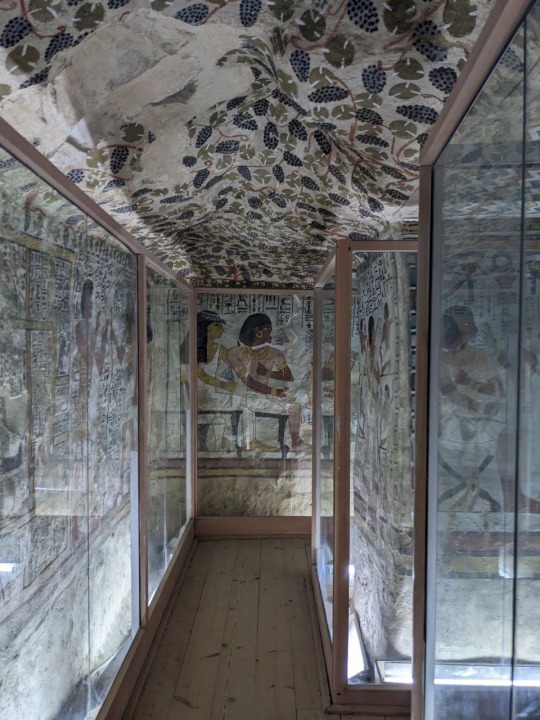
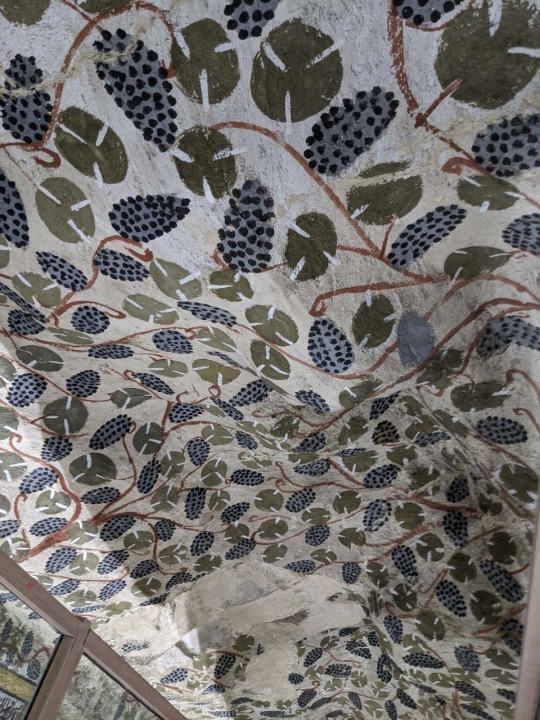


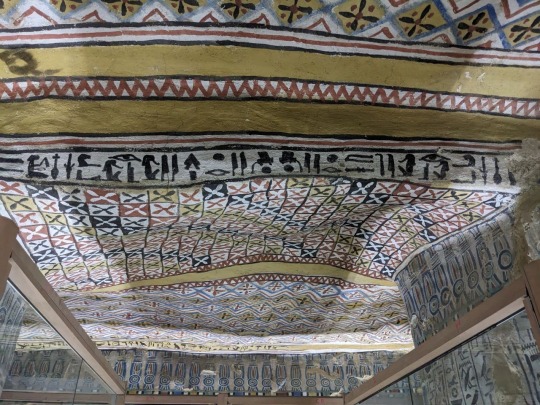
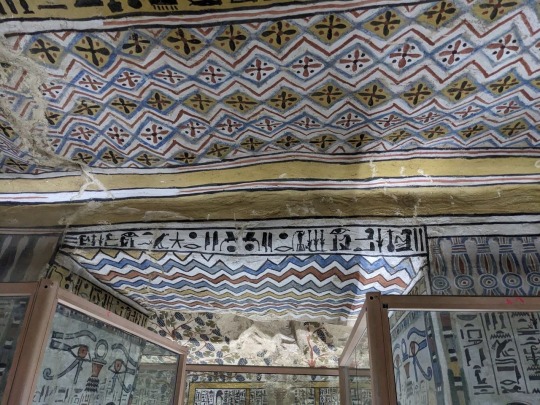
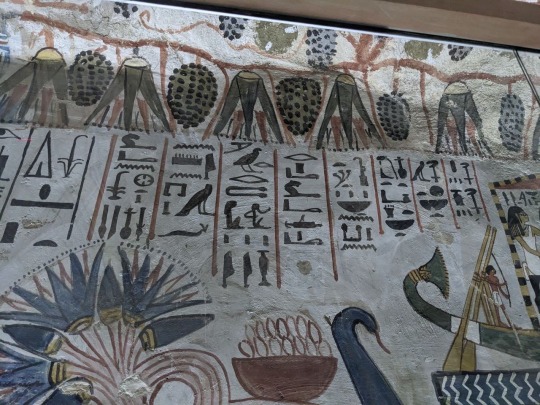
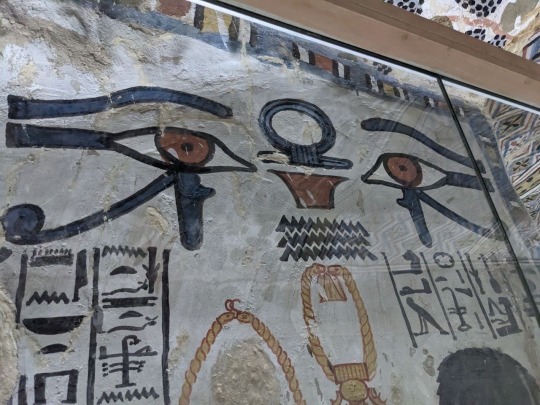
Ceiling and imagery of the Tomb of the Vineyards, burial of Sennefer, Mayor of the Southern City, Thebes, during the 18th dynasty of Egypt.
Photos taken by me, August 2023
It’s hard to tell which way is up and down when walking through the tunnel leading from the surface into the tomb. Before entering the main chamber there is a small antechamber whose ceiling is quite low, and then a shallow arch which leads to the main room depicted in the above photographs. Both chambers contain a good deal of paintings, however the main chamber holds the most numerous and well preserved paintings, of course. Besides the ceiling, everything is encased in glass.
#ancient egypt#egyptian mythology#egyptian hieroglyphs#egyptian art#ancient history#egyptian gods#egyptology#hieroglyphs#archaeology#egyptian history#egypt
2K notes
·
View notes
Text



~ Twenty-Nine Hole Game Board.
Date: ca. 664-332 B.C. (?)
Period: 26th dynasty, Late Period
#ancient#ancient art#history#museum#archeology#ancient egypt#ancient sculpture#ancient history#archaeology#egypt#egyptology#Egyptian#game#game board#26th Dynasty#late period#ca. 664 b.c.#ca. 332 b.c.
2K notes
·
View notes